XX International Scientific Conference for Students and Postgraduates “PROBLEMS OF THE ARCTIC REGION”
17-18 May 2023,
Murmansk
Инновации
Since the 1990s MMBI has carried out investigations on environmental impact assessment. Over the last years MMBI has carried out several projects on environmental engineering investigations and environmental impact assessments for several variants of subsea pipeline routes from the Shtokman gas-condensate deposit to different areas of the northern coast of Kola Peninsula (Teriberka Bay, Malaya Volokovaya Bay, Ura Bay, Pechenga Bay) as well as for construction of the Shtokman deposit facilities at the license site.
Building of new information technologies and databases on oceanography, hydrobiology, chemical and radioactive contamination of seas is a useful and challenging task carried out at MMBI. Over the last years several electronic atlases on the climate, plankton distribution, hydrochemistry and oceanography of the Arctic and Southern Seas of Russia have been created. The database includes data over the 200-year period (since 1810).
MMBI has been developing technologies for use of marine mammals in dual-purpose biotechnical systems. In order for this work to be carried out, MMBI established biotechnical marine mammal center with two experimental sites in the town of Polyarny and in the town of Gadzhievo. Methods of captive breeding and training of Greenland seals, grey seals, bearded seals, ringed seals, and white whales were first developed here to be used in technical, rescue, and antiterrorist underwater operations at sea under severe arctic conditions.
Studies on seals sensory systems respondent to visual and auditory stimuli under water and on air and on behavior of seals while provided complex skills training are carried out at the marine mammal centre in Polyarny. A long-term research on the pinnipeds ability to develop complex multilink skills was initiated. Methods of directed learning of seals to find and mark underwater objects on the open waters are tested as well.
MMBI scientists have developed technology for treatment of seawater with the help of sea weeds. The Fucus-Laminaria algae plantation technology based on sorption properties of brown algae prevents oil slick from spreading, acting as a slick bar, and contributes to rapid disposal of petroleum products and their decomposition by oil-oxidizing bacteria that form a symbiotic association with the algae. The results of simulation and in situ experiments have shown that 1 hectare of the plantation is able to neutralize approximately 100 kg of petroleum products per week. Workable experimental specimen of the plantation has been deployed in Dalnie Zelentsy Bay (East Murman Coast, Barents Sea).
One of the main directions of innovation activity of MMBI is mariculture of commercial species of marine hydrobionts and substantiation of multiple use of unconventional fishing objects.
MMBI developed and successfully tested methods of breeding of the red king crab using artificial forage at the aquaria room which is equipped with up-to-date autonomous temperature-controlled water supply system. The results of research will be the basis for the development of new biotechnologies of the red king crab mariculture and other hydrobionts of the Barents Sea.
MMBI also worked out biotechnologies for environmental monitoring and forecasting, like the method of biological monitoring based on the system of multi-level bioindication using aquatic animals. Based on the continuous in situ observation and registration of the state of aquatic animals (mussels in particular), the method enables to obtain at any time period reliable data on the environmental status of water medium exposed to man-caused impacts. The method also enables to track out cumulative effects in real field conditions. This method of biological monitoring is based on the multi-level system of biological indicators that characterize the functioning of the ecosystem by a complex of biological processes running at different rates, i.e. at different time scales, hierarchically. The changes are registered at different organizational levels of living organisms: organism, group, population, and ecosystem. The monitoring system has been tested in bays and inlets of the Barents Sea coast.
 The Federal Service for Intellectual Property, Patents and Trademarks has granted to the Institute a patent #2337571 (10.11.2008) for the invention “A method of complex processing of fucus algae (variants)”.
The Federal Service for Intellectual Property, Patents and Trademarks has granted to the Institute a patent #2337571 (10.11.2008) for the invention “A method of complex processing of fucus algae (variants)”.
The author of invention (the inventor) - Ekaterina D. Obluchinskaya.
Registered in the State Register of Inventions of the Russian Federation on 10 November 2008.
Patent validity: 11.08.2006-11.08.2026.
The invention relates to medical, pharmaceutical and food industry, and applies the technology of complex processing of fucus algae. The method of complete processing of bladder wrack (Fucus vesiculosus) provides for receiving of a lipid-pigment complex in the form of a thick extract and sodium alginate. The invention increases the yield of biologically active substances in the end products.
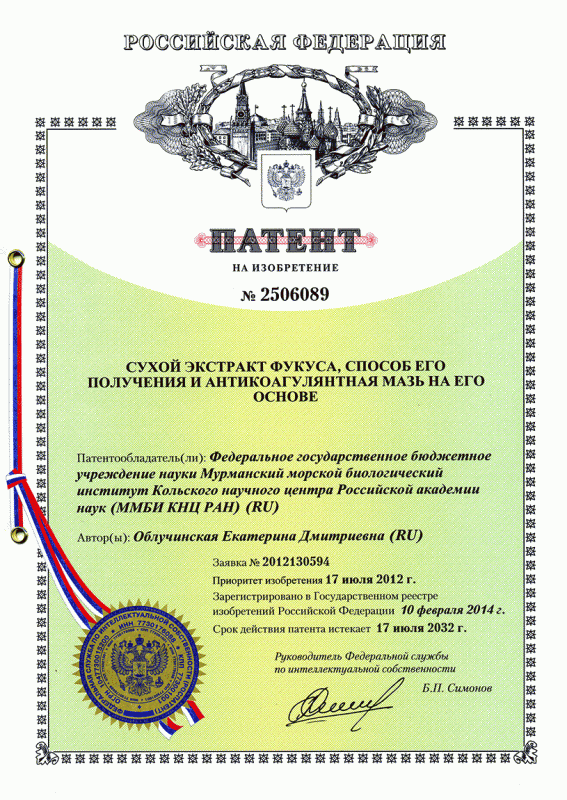
The Federal Service for Intellectual Property, Patents and Trademarks has granted to the Institute a patent # 2506089 (11.10.2013) for the “Dry Fucus extract, method for its preparation and formulation of anticoagulant ointment based on it” invention.
Proprietor – MMBI KSC RAS.
Inventor - Ekaterina D. Obluchinskaya.
Registered in the State Register of Inventions of the Russian Federation on 10 February 2014.
Patent validity: 17.07.2012-17.07.2032.
The invention relates to the pharmaceutical industry, namely to an agent possessing anticoagulant activity. A method for preparing a dry fucus extract having anticoagulant activity by complex treatment of Fucus vesiculosus is described. The dry Fucus extract is a polysaccharide complex containing fucoidan of the following composition: neutral monosaccharides - fucose, xylose, mannose, galacose, glucose, uronic acid; as well as polyphenols and sulphates in a specific amount. The anticoagulant ointment contains the dry fucus extract. The above described agents possess a pronounced anticoagulant action.
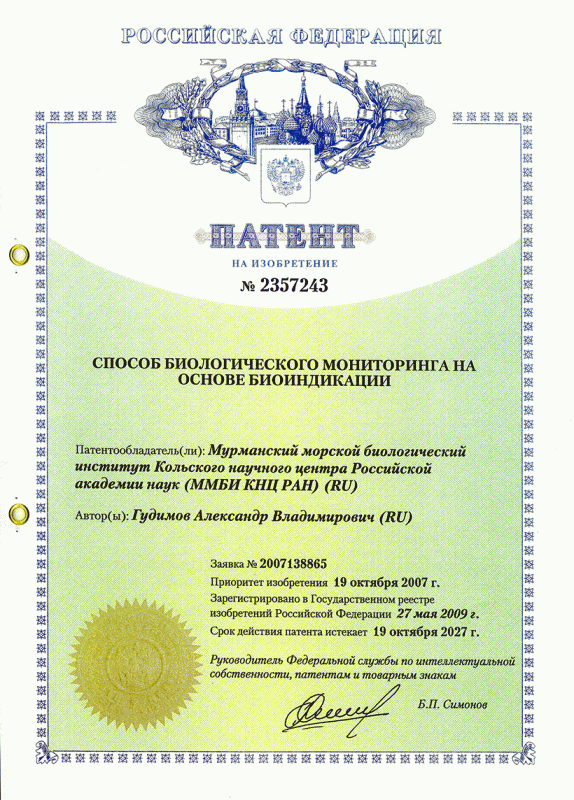 The Federal Service for Intellectual Property, Patents and Trademarks has granted to the Institute a patent # 2357243 (09.12.2008) for the invention “Method for biological monitoring based of bio-indication”.
The Federal Service for Intellectual Property, Patents and Trademarks has granted to the Institute a patent # 2357243 (09.12.2008) for the invention “Method for biological monitoring based of bio-indication”.
Proprietor - Murmansk Marine Biological Institute KSC RAS.
Inventor - Alexander V. Gudimov.
Registered in the State Register of Inventions of the Russian Federation on May 27, 2009.
Patent validity: 19.10.2007-19.10.2027.
The invention relates to the field of ecology. A biological monitoring method based on bioindication involves sampling of aquatic animals, measurement of such parameters as number, biomass, species diversity, areals and functional parameters of the organism, as well as main hydrological and hydrochemical indices determining on the basis spatial and temporal trends of indicator changes in biological parameters gradient of environmental factors. Biomonitoring is carried out continuously by means of a multi-level bio-indication, using several levels of organization of biological systems and the measurement of indicator parameters with different discontinuity. The invention can be used in carrying out of engineering and environmental surveys and EIA within the industrial development of marine areas.
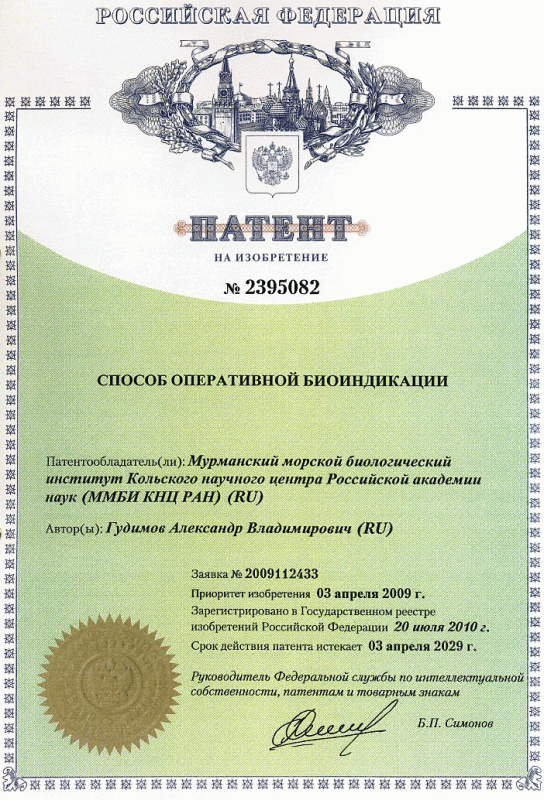
The Federal Service for Intellectual Property, Patents and Trademarks has granted to the Institute a patent # 2395082 (13.01.2010) for the invention of “A rapid bioindication method”.
Proprietor - MMBI KSC RAS.Inventor - Alexander V. Gudimov.
Registered in the State Register of Inventions of the Russian Federation on July 20, 2010.
Patent validity: 03.04.2009-03.04.2029.
The invention relates to ecology and environmental protection, including a realtime indication of pollution of natural waters. This method involves a continuous measurement of behavioural and/or physiological reactions of aquatic organisms under natural conditions. Measuring devices connected to a self-recording device or to a computer and a signaling device were used. Bioindication takes place based on results of complex changes in functional characteristics of indicator organisms. Values of measured parametres are processed by the computer in real time separately for each specific indicator organism with subsequent averaging and integration of the results. Changes are evaluated from measurements of not less than three main parametres of behavioural and/or physiological reactions of indicator organisms and their fluctuation frequency. By comparing the current state of the indicator organism with its normal state and analysing the integrated measurement results, an alarm signal is generated automatically. The said signal indicates changes in conditions of the aquatic medium and degree of deviation from normal conditions. Bioindication is carried out using not less than two types of indicator organisms for one and/or more biotopes, where different water layers or bodies are used as the biotopes. Reliability and efficiency are improved.
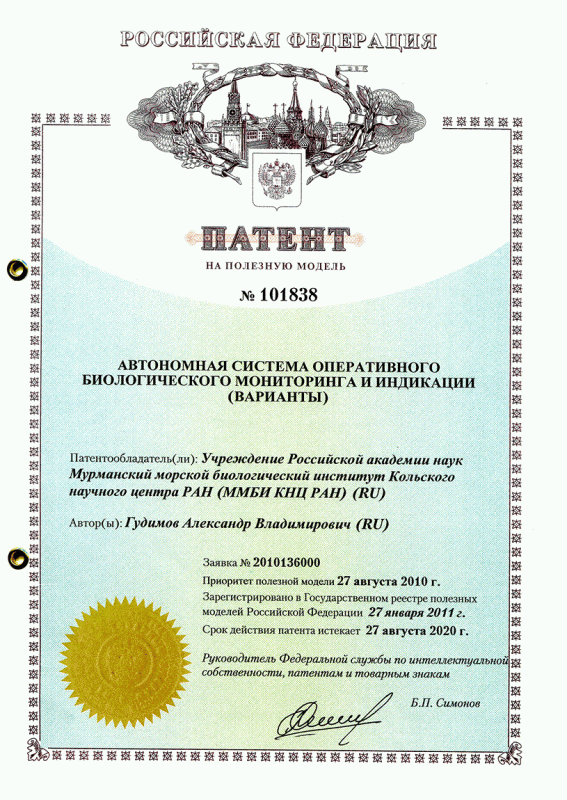
The Federal Service for Intellectual Property, Patents and Trademarks of, the Institute issued patent number # 101838 (21.10.2010) for an utility model “An autonomous system of operational (on-line) biological monitoring and indication (variants)”.
Proprietor - Murmansk Marine Biological Institute KSC RAS.Invenor - Alexander V. Gudimov.
Registered in the State Register of Utility Models of the Russian Federation on January 27, 2011.
Patent validity: 27.08.2010-27.08.2020.
An autonomous system of operational (on-line) biological monitoring and indication, including measuring instruments for continuous registration of behavioral and/or physiological responses of aquatic organisms, coupled with a computer and a signaling device, wherein the power source is placed on a floating structure or on the beach, measuring and registers the unit is installed on floating structures in a sealed box or under water or in a certain depth at the bottom, and n represents the reactions of measuring indicator aquatic organisms, where n = 2,3,4 ..., and the computer has a signaling device on the floating structure or onshore facility, the signals measuring means coming to a computer with appropriate software containing a database of state parameters of functional characteristics of different organisms indicator normally adapted to its constant updating and editing the values of the modified parameters are continuously processed by a computer in real time individually for each individual indicator, in excess of the degree of deviation of the mean values from the norm is automatically activated signaling device and generates a signal of alarm three stages - when there is a fault in one parameter, according to three parameters and all parameters in all organisms-indicators.
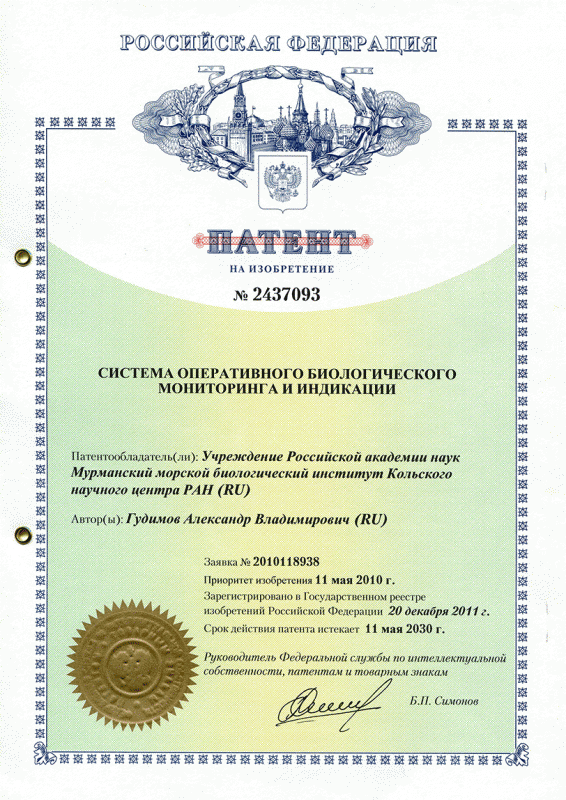 The Federal Service for Intellectual Property, Patents and Trademarks on 27.06.2011, the Institute has granted a patent # 2437093 for the invention “System for rapid biological monitoring and indication”.
The Federal Service for Intellectual Property, Patents and Trademarks on 27.06.2011, the Institute has granted a patent # 2437093 for the invention “System for rapid biological monitoring and indication”.
Inventor – Alexander V. Gudimov.
Registered in the State Register of Utility Models of the Russian Federation on December 20, 2011.
Patent validity: 11.05.2010-11.05.2030.
The invention is designed for continuous monitoring and assessment of water quality in real time. The Rapid biological monitoring and display consists of measuring and recording, analytical and signaling units. Measuring and recording unit is n of measuring reactions indicator aquatic organisms, where n = 2, 3, 4, or more than two tanks located therein with an indicator organism in which the aquarium water distributor fed, injected with the test pump horizon underwater water body or from the water. The parameters of the functional characteristics of the indicators are calculated by means of the measurement signals received by the analytical unit, which includes computer software which contains a database of state parameters of functional characteristics of different organisms indicator normally adapted to its constant updating and editing. The values of the measured parameters are processed by a computer continuously in real time, individually for each individual indicator organism. Upon deviation of average values from standard values, the signal unit is automatically switched off and a three-step alarm signal is generated - upon deviation from the standard on one parameter, on three parameters and on all parameters for all indicator organisms. The present invention provides improved accuracy and reliability of a continuous water quality control.

The Federal Service for Intellectual Property, Patents and Trademarks on 12.01.2012, has granted to the Institute a patent # 2452949 for the “Equipment system for continuous detection and measurement of motor activity of bivalve mollusks” invention.
Proprietor - MMBI KSC RAS.
Authors - Alexander V. Gudimov, Anton I. Burdygin, Vladimir P. Nesterov, Valentin F. Mitrofanov.
Registered in the State Register of Utility Models of the Russian Federation on June 10, 2012.
Patent validity 31.01.2011-31.01.2031.
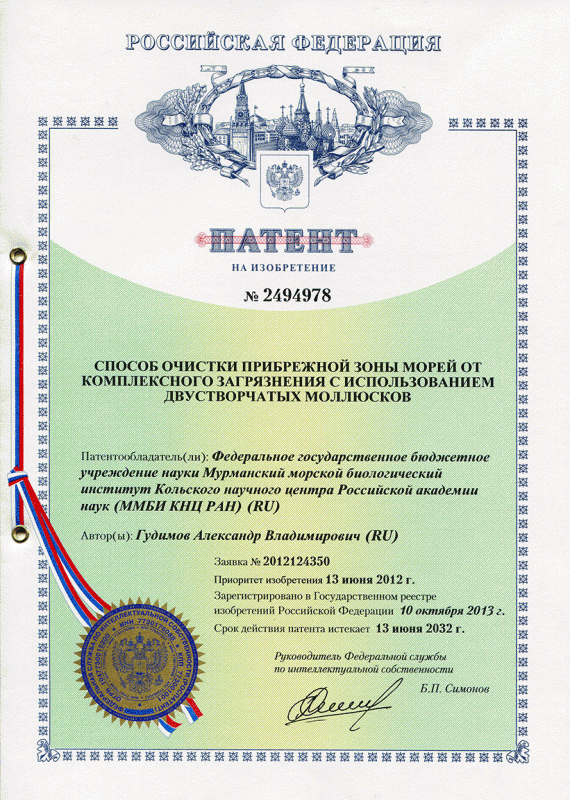 The Federal Service for Intellectual Property, Patents and Trademarks on 05.29.2013, has granted to the Institute a patent # 2494978 for the invention ”Method of purification of sea coastal zone from complex pollution with application of bivalves”.
The Federal Service for Intellectual Property, Patents and Trademarks on 05.29.2013, has granted to the Institute a patent # 2494978 for the invention ”Method of purification of sea coastal zone from complex pollution with application of bivalves”.
Proprietor - MMBI KSC RAS.
Inventor – Alexander V. Gudimov.
Registered in the State Register of Utility Models of the Russian Federation on 10 October 2013.
Patent validity: 13.06.2012-13.06.2032
1. The purification method of the coastal zone of seas, including the construction of the filter dam in the area of discharge of domestic and industrial wastewater on land at the edge of the shore, over which the coastal zone is placed at least three rows of bottom and/or floating installations for the cultivation of aquatic organisms, on which was placed dust the orchata shellfish, characterized in that the floating installation for cultivation of aquatic organisms is a circle of plastic pipes placed around a wooden spacer cross frames under which the buoyancy fixed plastic pipes, tubes and the frame attached artificial substrates, which are used coarse setae canvas, straightened or curled harness to the bottom of which is attached cargo for burial.
2. The method according to a claim 1, characterized in that the filter dam build one or two additional filtering of the dam.
3. The method according to a claim 1 or 2, characterized in that mussels are used as bivalves.
4. The method according to claim 1 or 2, characterized in that the bivalves after 2-5 years growing place on the net from pollution of waters for their detoxification.
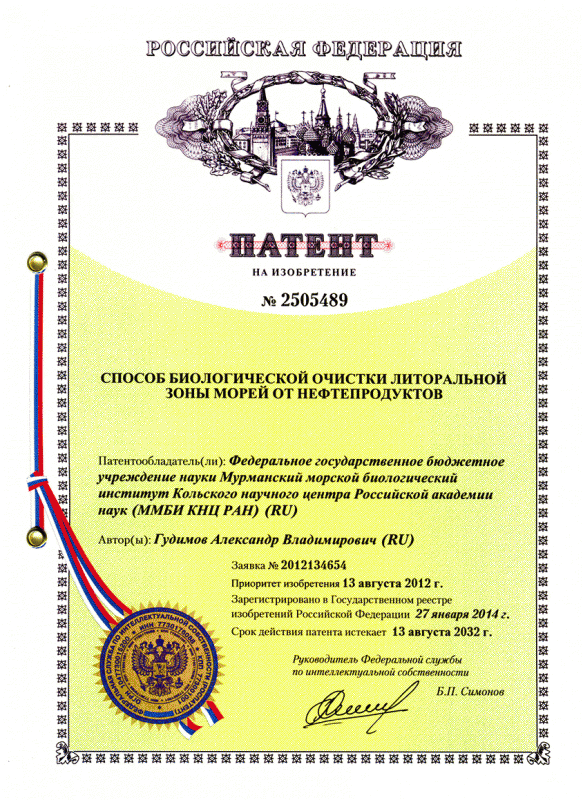 The Federal Service for Intellectual Property, Patents and Trademarks on 02.09.2013, has granted to the Institute a patent # 2505489 for the invention “A method for biological treatment of sea littoral zone from oil products”.
The Federal Service for Intellectual Property, Patents and Trademarks on 02.09.2013, has granted to the Institute a patent # 2505489 for the invention “A method for biological treatment of sea littoral zone from oil products”.
Proprietor - MMBI KSC RAS. Inventor - Alexander V. Gudimov.
Registered in the State Register of Utility Models of the Russian Federation on January 27, 2014.
Patent validity: 13.08.2012-13.08.2032.
The invention relates to biotechnology and provides a method for biological treatment of sea littoral zone from oil products. A method includes placing of bivalve mollusks in the areas contaminated with oil and oil products. In the places of contamination parallel to the coast line there were mounted not less than four rows of piles or columns. Large-cell net with mollusks is extended at every two rows of piles or columns in the direction from the coast towards the sea in the form of open wedges with wedges location in staggered manner. The mollusks on the net are grown on it before or set on it after the structure mounting. Reliability and efficiency of littoral zone treatment as well as coastal shallow areas or shallow-water coastal line of the sea were increased.
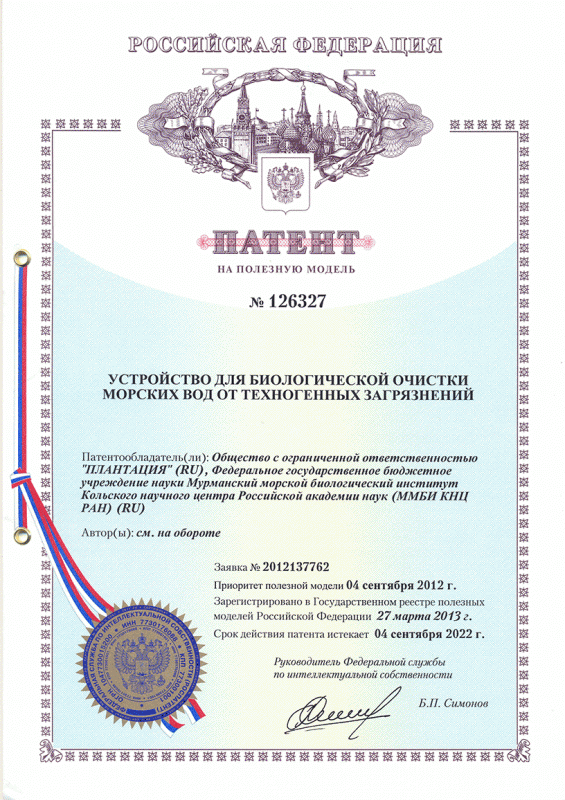
The Federal Service for Intellectual Property, Patents and Trademarks on 09.01.2013, has granted to the Institute a patent # 126327 for a utility model “A device for biological treatment of sea water from technogenic contaminants”.
Proprietors – a Limited liability company “PLANTATION” and MMBI KSC RAS.
Inventors – Grigory M. Voskoboynikov, Mikhail V. Makarov.
Registered in the State Register of Utility Models of the Russian Federation on 27 March 2013.
Patent validity: 04.09.2012-04.08.2022.
The experimental sanitary algae plantation is the innovative device for biological cleanup of seawater of technogenic pollution. It consists of nylon cable ropes of 30-40 mm in diameter attached to gravitation anchors. The floats are attached to the anchors with wire cables through fastening elements of floating buoys. These buoys are attached to cable ropes with tightened to them load-carrying cables to maintain the required configuration and orientation of the plantation. These cables serve as substrate for Laminaria thalli. The experimental plantation consists of engineering modules with horizontal cable ropes stretched on the water surface to bear fucus talli of 2 x1,5 m in length. The modules are made of nylon ropes of 10-20 mm in diameter providing the substrate for Fucus algae. These nylon ropes are attached to polypropylene ropes or wire cables by large floats. On the surface horizontal cable ropes there are close-by buoys with holes (3 cm between each) in the bottom to fasten fucus thalli so that to keep them afloat. A device for biological treatment of sea water from technologic contaminants according to claim 1, is characterized by use of buoys of minimum 20 × 15 cm made of porous material with a central through hole. The depth of holes to fasten the fucus thalli is 2-3 cm.
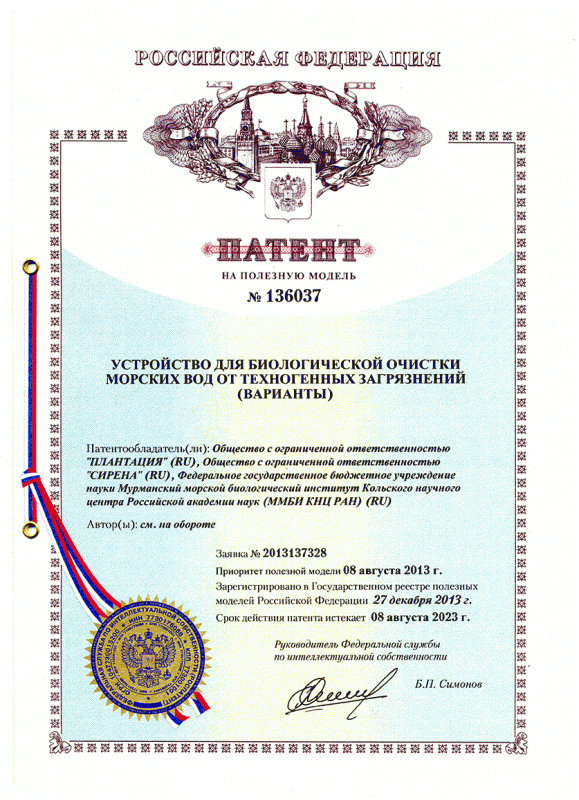 The Federal Service for Intellectual Property, Patents and Trademarks has granted to the Institute a patent #136037 for a utility model “A device for biological treatment of sea water from technogenic contaminants (variants)”.
The Federal Service for Intellectual Property, Patents and Trademarks has granted to the Institute a patent #136037 for a utility model “A device for biological treatment of sea water from technogenic contaminants (variants)”.
Proprietors – a Limited liability company “PLANTATION”, a Limited liability company “SIRENA” and MMBI KSC RAS.
Inventors - Grigory M. Voskoboynikov, Mikhail V. Makarov.
Registered in the State Register of Utility Models of the Russian Federation on December 27, 2013. Patent validity: 08.08.2013-08.08.2023.
1. The experimental sanitary algae plantation is the innovative device for biological cleanup of sea water of technogenic contaminants. It consists of nylon cable ropes of 30-40 mm in diameter attached to artificial anchors. The floats are attached to the anchors with nylon ropes. These floats are needed to keep the plantation load-carrying modules afloat. The modules are frames made of polypropylene grid with a mesh size of 80-120 mm, 1-2 m in width and 1 to 10 m in length. Horizontal cable ropes with entwined fucus plants are fastened to the load-carrying frame. The floats are mounted on the cable ropes at a distance of 2 m from each other and the frames can be connected to each other.
2. According to a claim 1, a device is characterized by distance floats made of plastic tubes sealed at the ends.
3. According to a claim 1, a device is characterized by the fucus thalli fixed at a grid at a distance of 10 cm from each other, while the average fucus weight per frame of 1 m2 is about 2 kg.
4. According to a claim 1, a device is characterized by fucus frames able to be rolled up.
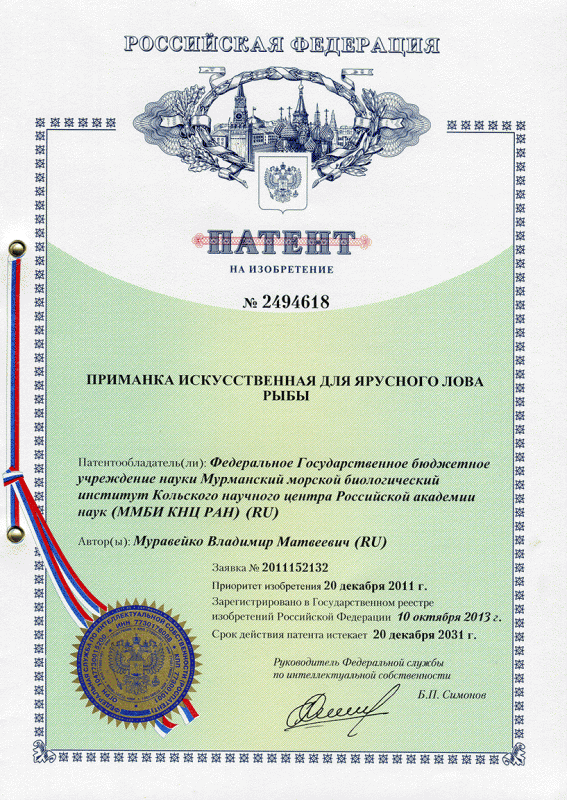 The Federal Service for Intellectual Property, Patents and Trademarks has granted to the Institute a patent # 2494618 (22.05.2013) for the invention of “An artificial bait for long-line fishing”.
The Federal Service for Intellectual Property, Patents and Trademarks has granted to the Institute a patent # 2494618 (22.05.2013) for the invention of “An artificial bait for long-line fishing”.
Proprietor - MMBI KSC RAS.
Inventor - Vladimir M. Muraveyko. Registered in the State Register of Utility Models of the Russian Federation on 10 October 2013.
Patent validity: 20.12.2011-20.12.2031.
An invention is intended for industrial long-line fishing and provides an attraction mixture containing fish waste production and/or seafood and gelatin. The bait comprises a carrier, which is used as a piece of Euceratosa impregnated with the filler. The filler is used as a thick broth of cod heads with gelatin in combination of 1:100 and the extract of the organs and tissues of the Icelandic scallop in concentration of 10-2 M.
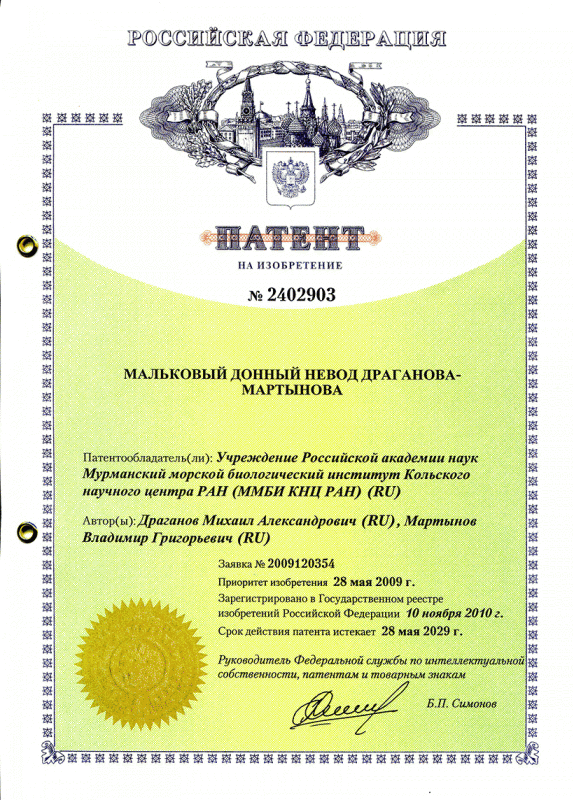 The Federal Service for Intellectual Property, Patents and Trademarks has granted to the Institute a patent # 2402903 (16.06.2010) for the invention “Minnow benthal seine of Draganov-Martynov”.
The Federal Service for Intellectual Property, Patents and Trademarks has granted to the Institute a patent # 2402903 (16.06.2010) for the invention “Minnow benthal seine of Draganov-Martynov”.
Proprietor - MMBI KSC RAS. Inventors - Michael A. Draganov, Vladimir G. Martynov.
Registered in the State Register of Inventions of the Russian Federation on 10 November 2010. Patent validity: 28.05.2009-28.05.2029.
A seine includes wings, purse with shut-off valve, cod end, upper and lower rebounds. The front edge of the shut-off valve is connected to the purse. The trailing edge of the shut-off valve is in a free state. Shut-off valve is made in the form of a truncated quadrangular pyramid. The front edge of the quadrangular pyramid on its perimeter is connected to the back of the purse. The seine has an insert-shield made of two lateral wedge plates and the base connected to each other. The base is connected with the top of framing wire purse. Lateral plates with one of its edges are connected to the top framing wire of wings. Other edges are in a free state. The bottom framing wire is equipped with a counter. This design enables to enhance the seine catchability and area of catches, increase the effectiveness of fishery research in continental waters.
 The Federal Service for Intellectual Property, Patents and Trademarks has granted to the Institute a patent #113178 (18.11.2011) for a utility model “A device for the mounting of biological cells on coverslips with centrifugation”.
The Federal Service for Intellectual Property, Patents and Trademarks has granted to the Institute a patent #113178 (18.11.2011) for a utility model “A device for the mounting of biological cells on coverslips with centrifugation”.
Proprietor - MMBI KSC RAS.
Inventors – Irina A. Erokhina, Nikolay N. Kavtsevich, Tatiana V. Minzyuk.
Registered in the State Register of Utility Models of the Russian Federation on February 10, 2012. Patent validity: 17.10.2011-17.10.2021.
A device for the mounting of biological cells on coverslips with centrifugation consists of a coverslip, container, which is a hollow plastic cylinder, and a device for adjusting the container to a centrifuge, which comprises an inset coupling sleeve and the stopper; at the top of the container and in the bottom of the sleeve there are holes for their connection with the stopper; the container has a flat bottom whereon a coverslip is placed.
 The Federal Service for Intellectual Property, Patents and Trademarks has granted to the Institute a patent # 93624 (26.01.2010) for a utility model “An enclosure complex for keeping and research of marine mammals”.
The Federal Service for Intellectual Property, Patents and Trademarks has granted to the Institute a patent # 93624 (26.01.2010) for a utility model “An enclosure complex for keeping and research of marine mammals”.
Proprietor - MMBI KSC RAS.
Inventors –Aleksander S. Gladkikh, Nikolay N. Kavtsevich, Aleksander M. Kalinin, Aleksander L. Mikhayliuk
Registered in the State Register of Utility Models of the Russian Federation on May 10, 2010.
Patent validity: 25.12.2009-25.12.2019.
An enclosure complex consists of a support frame made in the form of a pontoon with attached to it mesh enclosures/ cages equipped with the strut frames in the bottom; platforms to move along each enclosure, fencing and decking for staff getting around. The complex includes from 4 to 7 enclosures, each enclosure has a perimeter fence with the netting. The pontoon and enclosures fencing are made of interconnected plastic tubes, wherein a strut frame is fixed to the outside of the enclosure netting.
 The Federal Service for Intellectual Property, Patents and Trademarks has granted to the Institute a patent # 147813 (25.02.2014) for a utility model “A floating device for transporting of marine mammals”.
The Federal Service for Intellectual Property, Patents and Trademarks has granted to the Institute a patent # 147813 (25.02.2014) for a utility model “A floating device for transporting of marine mammals”.
Proprietor - MMBI KSC RAS.
Inventors - Aleksander L. Mikhayliuk, Dmitriy G. Ishkulov, Aleksander R. Troshichev, Ilyia M. Koshcher.
Registered in the State Register of Utility Models of the Russian Federation on October 14, 2014. Patent validity: 04.07.2014–04.07.2024.
1. A floating device for transporting of marine mammals consists of a mean to provide a floatability and a cage with front gates. The cage is made as a solid base of timber disposed below the waterline and covered with a knotted fabric. It is mounted between the float means made of plastic pipe. At the ends of floats there are eyebolts attached; a base and floats are mounted on a transverse support beams.
2. The floating device according to a claim 1 is characterized by the base size of 2400x800x840 mm made of 40x40 mm beam.
3. A floating device according to a claim 1 is characterized by a knotted fabric made of synthetic halyard rope of 3 mm in diameter with a 30 mm mesh.
4. The floating device according to a claim 1 is characterized by the base and floats are mounted on a transverse support beams with half-yokes.
5. For the floating device according to a claim 1 it is characteristic to use a plastic pipe of 210 mm in diameter and 2700 mm in length as a float.
 The Federal Service for Intellectual Property, Patents and Trademarks has granted to the Institute a patent # 91683 (18.11.2011) for a utility model “A table for washing and analysis of benthos samples”.
The Federal Service for Intellectual Property, Patents and Trademarks has granted to the Institute a patent # 91683 (18.11.2011) for a utility model “A table for washing and analysis of benthos samples”.
Proprietor - MMBI KSC RAS.
Inventors – Evgeny A. Garbul. Registered in the State Register of Utility Models of the Russian Federation on February 27, 2010.
Patent validity: 16.10.2009-16.10.2019.
A table for washing and analysis of benthos samples consists of a worktop with a skirting board and a drainage hole, support elements and a set of detachable sieves. The worktop is made in the shape of a truncated pyramid, the shorter base of which is a drain hole, the longer base has attached crossbar holders to hold the upper metal sieve. On the upper metal sieve a removable mounting pad made of steel holders is installed, the lower sieve in the form of a truncated ellipsoid is set on horizontal bars rigidly connected to the support elements of the table. A drainage hole has a lower shoulder in the lower sieve.
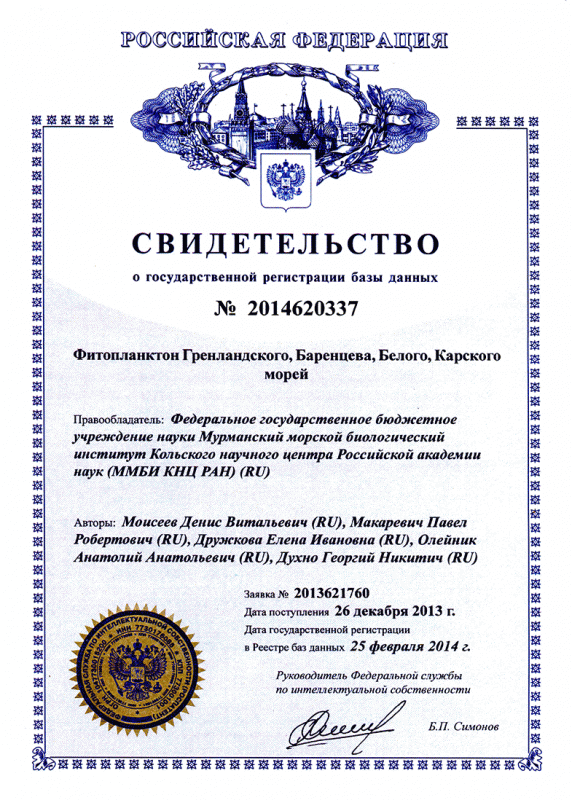 The Federal Service for Intellectual Property, Patents and Trademarks has granted to the Institute a patent # 2014620337 (25.02.2014) for a database “Phytoplankton from the Greenland Sea, the Barents Sea, the White Sea and the Kara Sea”.
The Federal Service for Intellectual Property, Patents and Trademarks has granted to the Institute a patent # 2014620337 (25.02.2014) for a database “Phytoplankton from the Greenland Sea, the Barents Sea, the White Sea and the Kara Sea”.
Proprietor - MMBI KSC RAS.
Inventors - Denis V. Moiseev, Pavel R. Makarevich, Elena I. Druzhkova, Anatoliy A. Oleiynik, Georgiy N. Dukhno.
Registered in the State Register of Utility Models of the Russian Federation on February 25, 2014.
The database contains information on the status of phytoplankton collected by the authors during marine expeditions in the period 1999-2011. It can be used to analyze the spatial and temporal variability of the Arctic seas ecosystems in a changing climate. The database includes information on 554 samples of phytoplankton sampled in 27 expeditions, including the date, time, geographical coordinates, the depth of the sea, the horizon and the area of selection, as well as a list of detected phytoplankton species, their number per unit volume. The database is kept up to date and structurally enlarged. It is possible to make requests for data search by various criteria. Visualization of query results based on the mapping is carried out by means of GIS.
Type of computer: IBM PC Pentium 166/200 and higher
RDBMS: MS Excel and Access 2003-2007, ArcGIS 9.3
OS: Windows 95/98 and higher.
Database size: 10 MB



 English
English
